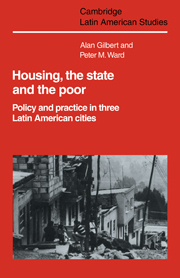Book contents
- Frontmatter
- Contents
- List of figures
- List of tables
- Acknowledgements
- Abbreviations
- 1 Introduction: the research issues and strategy
- 2 Bogotá, Mexico City and Valencia: the social, economic and political backcloth
- 3 Access to land
- 4 Servicing low-income settlements
- 5 Community organization: participation or social control?
- 6 Conclusions
- Appendix 1 The methodology in detail
- Appendix 2 Description of the survey settlements
- Notes
- Bibliography
- Author index
- Subject index
- CAMBRIDGE LATIN AMERICAN STUDIES
4 - Servicing low-income settlements
Published online by Cambridge University Press: 04 August 2010
- Frontmatter
- Contents
- List of figures
- List of tables
- Acknowledgements
- Abbreviations
- 1 Introduction: the research issues and strategy
- 2 Bogotá, Mexico City and Valencia: the social, economic and political backcloth
- 3 Access to land
- 4 Servicing low-income settlements
- 5 Community organization: participation or social control?
- 6 Conclusions
- Appendix 1 The methodology in detail
- Appendix 2 Description of the survey settlements
- Notes
- Bibliography
- Author index
- Subject index
- CAMBRIDGE LATIN AMERICAN STUDIES
Summary
Once land has been acquired, communities petition the respective public utilities for services. In this chapter we are concerned with explaining how these services are supplied and distributed, the procedures of the agencies, the power they have, how they use that power, and how successfully they service the city populations.
In the first section, we consider certain theories that explain the growth of government intervention in the urban economy. How has the government come to be involved in these areas? Has it been stimulated by economic or by social considerations, has intervention been in the field of collective consumption or collective production? Has government commitment to urban infrastructure and services generally increased or decreased? Has government servicing of poor people been widespread, motivated by a genuine desire to improve living standards, or has it been limited, the outcome of campaigns to maintain legitimacy and social control? In the second section, we provide a resumé of the organization of servicing and government activity in each city. Which services are provided by government and which by the private sector? In the third section, we provide an institutional guide to the organization of servicing in each city, relating service activity to the structure of government in each country and city. In the fourth section, we consider how government agencies perform their role. What are the main characteristics of the agencies supplying services to the poor?
- Type
- Chapter
- Information
- Housing, the State and the PoorPolicy and Practice in Three Latin American Cities, pp. 130 - 173Publisher: Cambridge University PressPrint publication year: 1985

